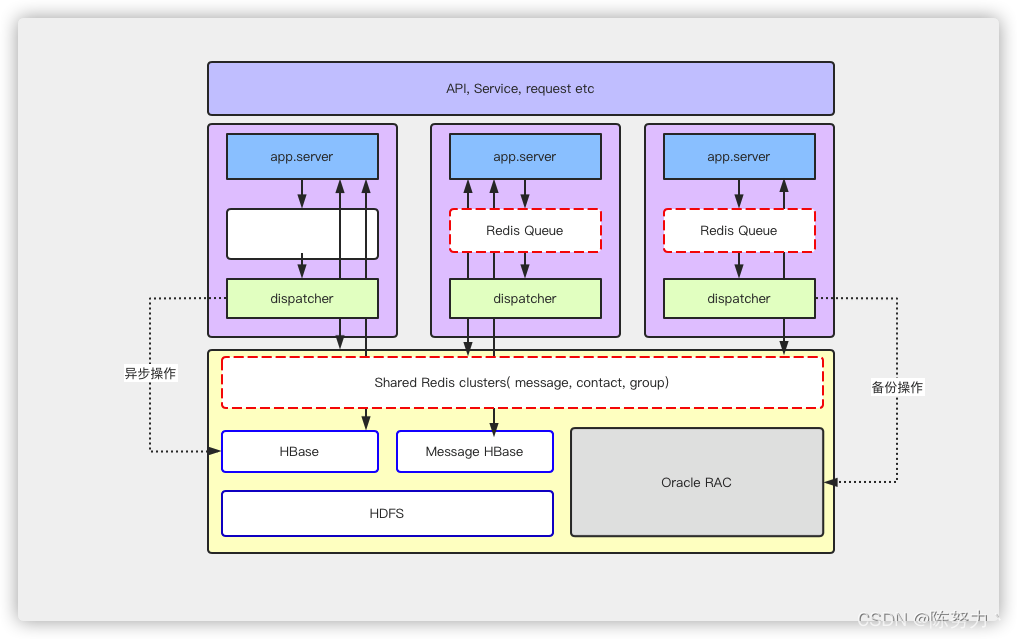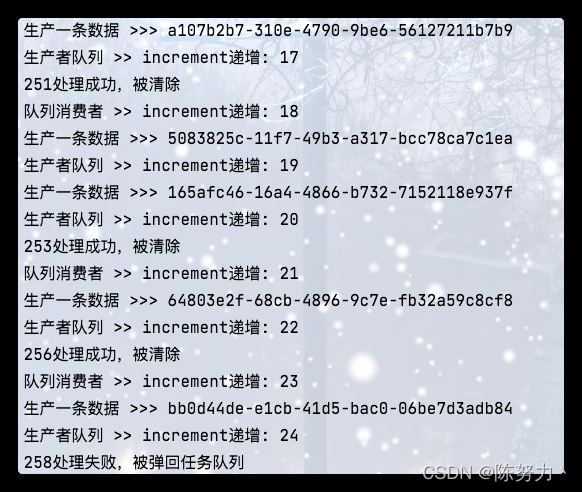溫馨提示×
您好,登錄后才能下訂單哦!
點擊 登錄注冊 即表示同意《億速云用戶服務條款》
您好,登錄后才能下訂單哦!
這篇文章主要介紹Java redisTemplate阻塞式處理消息隊列的示例分析,文中介紹的非常詳細,具有一定的參考價值,感興趣的小伙伴們一定要看完!


package cn.stylefeng.guns.knowledge.modular.knowledge.schedule;
import lombok.extern.slf4j.Slf4j;
import org.springframework.data.redis.core.RedisTemplate;
import java.util.Random;
import java.util.UUID;
/**
* <p>
* 隊列生產者
* </p>
*
* @SINCE 2021/11/30 21:03
* @AUTHOR dispark
* @Date: 2021/11/30 21:03
*/
@Slf4j
public class QueueProducer implements Runnable {
/**
* 生產者隊列 key
*/
public static final String QUEUE_PRODUCTER = "queue-producter";
private RedisTemplate<String, Object> redisTemplate;
public QueueProducer(RedisTemplate<String, Object> redisTemplate) {
this.redisTemplate = redisTemplate;
}
@Override
public void run() {
Random random = new Random();
while (true) {
try {
Thread.sleep(random.nextInt(600) + 600);
// 1.模擬生成一個任務
UUID queueProducerId = UUID.randomUUID();
// 2.將任務插入任務隊列:queue-producter
redisTemplate.opsForList().leftPush(QUEUE_PRODUCTER, queueProducerId.toString());
log.info("生產一條數據 >>> {}", queueProducerId.toString());
} catch (Exception e) {
e.printStackTrace();
}
}
}
}package cn.stylefeng.guns.knowledge.modular.knowledge.schedule;
import lombok.extern.slf4j.Slf4j;
import org.springframework.data.redis.core.RedisTemplate;
import java.util.Random;
/**
* <p>
* 隊列消費者
* </p>
*
* @SINCE 2021/11/30 21:14
* @AUTHOR dispark
* @Date: 2021/11/30 21:14
*/
@Slf4j
public class QueueConsumer implements Runnable {
public static final String QUEUE_PRODUCTER = "queue-producter";
public static final String TMP_QUEUE = "tmp-queue";
private RedisTemplate<String, Object> redisTemplate;
public QueueConsumer(RedisTemplate<String, Object> redisTemplate) {
this.redisTemplate = redisTemplate;
}
/**
* 功能描述: 取值 - <brpop:阻塞式> - 推薦使用
*
* @author dispark
* @date 2021/11/30 21:17
*/
@Override
public void run() {
Random random = new Random();
while (true) {
// 1.從任務隊列"queue-producter"中獲取一個任務,并將該任務放入暫存隊列"tmp-queue"
Long ququeConsumerId = redisTemplate.opsForList().rightPush(QUEUE_PRODUCTER, TMP_QUEUE);
// 2.處理任務----純屬業務邏輯,模擬一下:睡覺
try {
Thread.sleep(1000);
} catch (InterruptedException e) {
e.printStackTrace();
}
// 3.模擬成功和失敗的偶然現象,模擬失敗的情況,概率為2/13
if (random.nextInt(13) % 7 == 0) {
// 4.將本次處理失敗的任務從暫存隊列"tmp-queue"中,彈回任務隊列"queue-producter"
redisTemplate.opsForList().rightPush(TMP_QUEUE, QUEUE_PRODUCTER);
log.info(ququeConsumerId + "處理失敗,被彈回任務隊列");
} else {
// 5. 模擬成功的情況,將本次任務從暫存隊列"tmp-queue"中清除
redisTemplate.opsForList().rightPop(TMP_QUEUE);
log.info(ququeConsumerId + "處理成功,被清除");
}
}
}
}@Test
public void QueueThreadTotalEntry() throws Exception {
// 1.啟動一個生產者線程,模擬任務的產生
new Thread(new QueueProducer(redisTemplate)).start();
Thread.sleep(15000);
// 2.啟動一個線程者線程,模擬任務的處理
new Thread(new QueueConsumer(redisTemplate)).start();
// 3.主線程
Thread.sleep(Long.MAX_VALUE);
}線程一:
Long increment = redisTemplate.opsForValue().increment("increment", 1L);
log.info("隊列消費者 >> increment遞增: {}", increment);線程二:
Long increment = redisTemplate.opsForValue().increment("increment", 1L);
log.info("生產者隊列 >> increment遞增: {}", increment);
redisTemplate處理/獲取redis消息隊列
(參考代碼)
/**
* redis消息隊列
*/
@Component
public class RedisQueue {
@Autowired
private RedisTemplate redisTemplate;
/** ---------------------------------- redis消息隊列 ---------------------------------- */
/**
* 存值
* @param key 鍵
* @param value 值
* @return
*/
public boolean lpush(String key, Object value) {
try {
redisTemplate.opsForList().leftPush(key, value);
return true;
} catch (Exception e) {
e.printStackTrace();
return false;
}
}
/**
* 取值 - <rpop:非阻塞式>
* @param key 鍵
* @return
*/
public Object rpop(String key) {
try {
return redisTemplate.opsForList().rightPop(key);
} catch (Exception e) {
e.printStackTrace();
return null;
}
}
/**
* 取值 - <brpop:阻塞式> - 推薦使用
* @param key 鍵
* @param timeout 超時時間
* @param timeUnit 給定單元粒度的時間段
* TimeUnit.DAYS //天
* TimeUnit.HOURS //小時
* TimeUnit.MINUTES //分鐘
* TimeUnit.SECONDS //秒
* TimeUnit.MILLISECONDS //毫秒
* @return
*/
public Object brpop(String key, long timeout, TimeUnit timeUnit) {
try {
return redisTemplate.opsForList().rightPop(key, timeout, timeUnit);
} catch (Exception e) {
e.printStackTrace();
return null;
}
}
/**
* 查看值
* @param key 鍵
* @param start 開始
* @param end 結束 0 到 -1代表所有值
* @return
*/
public List<Object> lrange(String key, long start, long end) {
try {
return redisTemplate.opsForList().range(key, start, end);
} catch (Exception e) {
e.printStackTrace();
return null;
}
}
}以上是“Java redisTemplate阻塞式處理消息隊列的示例分析”這篇文章的所有內容,感謝各位的閱讀!希望分享的內容對大家有幫助,更多相關知識,歡迎關注億速云行業資訊頻道!
免責聲明:本站發布的內容(圖片、視頻和文字)以原創、轉載和分享為主,文章觀點不代表本網站立場,如果涉及侵權請聯系站長郵箱:is@yisu.com進行舉報,并提供相關證據,一經查實,將立刻刪除涉嫌侵權內容。